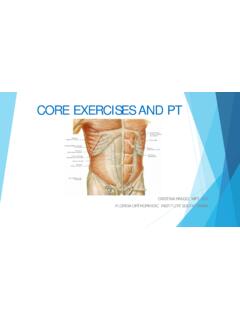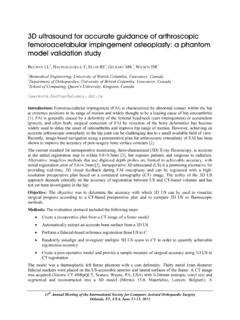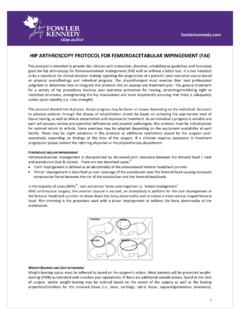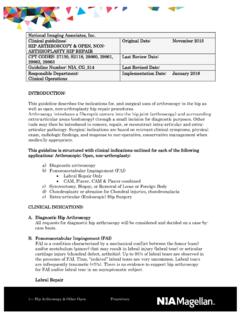Transcription of Arthroscopic Hip Capsular Reconstruction - foreonline.org
1 11/16/20151 Arthroscopic Hip Arthroscopic Hip Capsular Reconstruction Capsular Reconstruction Using Human Dermal Allograft Using Human Dermal Allograft for severe Capsular deficiencyfor severe Capsular deficiencyDerek Ochiai, MDNirschl Orthopaedic CenterNovember 6, : Smith & : Arthrex, BregIntroductionIntroduction The hip capsule has become increasingly recognized as an important static stabilizer of the hipp Arthroscopic management of the hip capsule is evolving, with greater emphasis placed on Capsular repair/plication**Harris et al, Arthrosc Tech 2013 Domb, Philippon, Giordano Arthroscopy2013 Domb et al. Am J Sports Med, 2013 Thakral, Ochiai Arthrosc Tech 201411/16/20152 IntroductionIntroduction Ehlers-Danlos Syndrome and Hyperlaxity Syndrome is being increasingly recognized as a concomitant condition with hip hl*pathology * In addition, hip arthroscopy may iatrogenically cause hip Capsular deficiency#*Larson et al Arthroscopy2015#Trindale et.
2 Al, Arth Tech, 2015 Case reportCase report 33 year old female with geneticist confirmed Ehlers-Danlos Syndrome (EDS) Three prior hip Arthroscopic procedurespppp First 2012- for anterior hip pain with labral repair and cam/pincer FAI osteoplasty Second 2013-labral debridement for feelings of instability and catching in her hip Third 2015-attempted Capsular plication (one suture) for microinstability with feelings of the hip slipping out of joint Case reportCase report Upon presentation, she would have microinstability events at least twice a day, with feelings of subluxation with getting out fb diffbof bed to stepping off a curb She is a law student, and her hip is affecting her ability to concentrate for her studies11/16/20153 Case reportCase report On Physical examination Pain with hip flexion to 95 degrees (120 degrees left) Internal rotation to 15 degrees (20 degrees left) External rotation to 80 degrees (90 degrees left) Positive apprehension with FABER position Positive anterior impingement testCase reportCase report CT scan showed no evidence of dysplasia (CE angle 27 degrees) MRI showed a large Capsular defect MRI showed a large Capsular defectCase reportCase report11/16/20154 Case reportCase report Surgical findings.
3 Thin, non-functional labrum Significantly thin capsule with irreparableSignificantly thin capsule with irreparable lateral defect Mild residual CAM FAI distally with functional testingCase reportCase reportCase reportCase report11/16/20155 Case reportCase reportCase reportCase reportCase reportCase report11/16/20156 Case reportCase reportDiscussionDiscussion The capsule of the hip can be an important static stabilizer Most cases of Capsular deficiency is Most cases of Capsular deficiency is iatrogenic With an irreparable Capsular defect, Capsular Reconstruction is a viable optionThanks for Thanks for listeninglisteningTwitter: @DrDerekOchiaiWebsite: The capsule of the hip can be an important static stabilizer Most cases of Capsular deficiency is Most cases of Capsular deficiency is iatrogenic With an irreparable Capsular defect, Capsular Reconstruction is a viable optionHip AnatomyHip Anatomy Hip joint is a synovial ball and socket joint Movements allowed are flexion/extensionare flexion/extension, adduction/abduction, and internal/external rotation Compared with shoulder, less mobility and more stabilityHip AnatomyHip Anatomy Tough synovial capsule Stability arises from its concentric ball and socket configuration Rim of surrounding Type II cartilage labrum 11/16/20158 Hip AnatomyHip Anatomy Labrum Deepens the dish of theof the acetabulum Assists with stability of hip in extremes of motionHip AnatomyHip Anatomy Other ligaments that contribute stability.
4 Y Ligament of Y Ligament of Bigelow (iliofemoral ligament) Pubofemoral ligament Ilioischial ligamentNeurovascular structuresNeurovascular structures Femoral nerve, artery, and vein anteriorlyy Sciatic nerve posteriorly Both are usually safe11/16/20159 Neurovascular structuresNeurovascular structures Lateral femoral cutaneous nerve is nerve at most direct risk of injuryrisk of injury (meralgia paresthetica) Pudendal nerve is most commonly affected (because of pressure from the post)Why do hip arthroscopy at all?Why do hip arthroscopy at all? Minimally invasive surgery Quicker recovery Preserves normal hip anatomy Avoids patient limitations associated with total hip replacements Allows access to spaces that are more difficult to gain through open techniquesIndicationsIndications Loose bodies in the hip joint LABRAL TEARS Snapping Hip Ruptured ligamentum teres Hip sepsis femoroacetabular impingement Snapping Hip Synovial chondromatosis Adhesive capsulitis Deep gluteal pain syndromeIMPINGEMENT SYNDROME (FAI) Gluteus medius/minimus tears Greater trochanteric pain syndrome11/16/201510 ContraContra--indicationsindications Ankylosis of the joint Poor bone quality Open wounds or sores Systemic infection Severe obesity (?)
5 Patient SelectionPatient Selection As with any surgery, the key to a good outcome is choosing patients hill lik lbi h hwho will likely get better with the intervention! We may not make you better, but we can surely make you different LOOSE BODIESLOOSE BODIES11/16/201511 Loose bodiesLoose bodies Classic bullet in the hip Excellent results Excellent results with Arthroscopic management Can be technically challengingArthroscopy: The Journal of Arthroscopic and Related Surgery, Vol 19, No 9 (November), 2003: E76 Loose bodiesLoose bodies Obviously, loose bodies from chondral sourceschondral sources are far more commonArthroscopy: The Journal of Arthroscopic and Related Surgery, Vol 19, No 9 (November), 2003: E76 LABRAL TEARS OF LABRAL TEARS OF THE HIPTHE HIPTHE HIPTHE HIP11/16/201512 Labral TearsLabral Tears Hip labral tears are the equivalent of meniscal tears in the kneeSt ildthi d Symptoms include catching and locking Pain is usually in the groin, but can radiate posteriorly or down the thighLabral TearsLabral Tears Pain with rising from a seated position Pain with twisting activities Pain getting in and out of cars Pain with sexual activityValidated Outcome StudiesValidated Outcome Studies HOS-Sport Modified HHSNAHS NAHS MHOT 14 or MHOT 3311/16/201513 Physical ExaminationPhysical Examination Range of motion Lumbar nerve stretch testsGtthtitd Greater trochanteric tendernessPhysical ExaminationPhysical Examination McCarthy test Supine positioning.
6 Flexion of hip, with p,external rotation and ExaminationPhysical Examination Anterior impingement test Supine positioning. Forced flexion, adduction, and internal ExaminationPhysical Examination Twist test Done standing. Patient faces the examiner, with knees bent to 30 degrees. Patient g windshield wipers knees back and forth. Patient will then repeat with standing on one leg, then the other, with the examiner holding patients hands for balance testTwist testTwist TestTwist Test11/16/201515 Radiology ExaminationRadiology Examination Plain radiographs can be very helpful CAM FAI best seen on lateral X-ray PINCER FAI best defined on an AP pelvis PINCER FAI best defined on an AP pelvis X-ray11/16/201516 Radiographic EvaluationRadiographic EvaluationRadiology ExaminationRadiology ExaminationRadiology ExaminationRadiology Examination11/16/201517 Radiology ExaminationRadiology ExaminationRadiology ExaminationRadiology Examination MRI arthrogram is most sensitive test for diagnosisCb fl Can be useful to add marcaine along with gadolinium, to confirm intra-articular source of pain when positive (less than 50%)
7 NOT ALL SNAPS IN THE NOT ALL SNAPS IN THE HIP ARE FROM LABRAL HIP ARE FROM LABRAL TEARSTEARS11/16/201518 Snapping hipSnapping hip Most snapping hips are asymptomaticand do not require treatment In rare instances, the snapping causes painpain Must differentiate between internal (iliopsoas tendon snapping over the hip) and external (iliotibial band snapping over the greater trochanter) and intra-articular (from an unstable labral tear or loose body)Snapping hipSnapping hip Internal snapping hip can be addressedaddressed through Arthroscopic iliopsoas releaseSnapping hipSnapping hip External snapping hip can be addressedbe addressed through Arthroscopic iliotibial band releaseIlizaliturri et al. Arthroscopy 2006; Snapping HipExternal Snapping HipExternal Snapping HipExternal Snapping Hip11/16/201520 femoroacetabular femoroacetabular impingement impingement SYNDROMESYNDROMEF emoroacetabular ImpingementFemoroacetabular impingement Concept introduced by Murray (a) Popularized by Ganz (b) Two types: Pincer and camyp Some experimental evidence that this is involved in the final common pathway to the development of hip arthritis(a) Murray, RO, Br J Radiol 1965: 38; 810-824.
8 (b) Ganz et al., Clin Orthop 2003: 417; , Clin Orthop Related Res 200411/16/201521 DiagnosisDiagnosis Clinical symptoms overlap greatly with labral tears, and FAI co-exists with labral tearslabral tears Diagnosis may be made on plain film or MRI Be sure that the radiologist reading the MRI has experience with the diagnosisDiagnosisDiagnosis Pain with sitting Pain with rising from a seated itiposition Pain with twisting activities Pain getting in and out of cars Pain with sexual activityDiagnosisDiagnosis Patients will often have a characteristic slouch with affected hip extended, because flexion hurtsbecause flexion hurts Sitting closer to the edge of the seat Listing toward unaffected side Affected foot is farther forward Leg is externally rotated11/16/201522 DiagnosisDiagnosis impingement test-flexion and internal rotation increases painLi it tif fl idi ll Limitation of flexion and especially internal rotation Twist test FAI Slouch FAI Slouch FAIFAI Open treatment has been gold standard Requires an open arthrotomy with dislocation of the femoral head (a)dislocation of the femoral head (a) Recently, this condition is being treated by Arthroscopic osteoplasty of the femoral head, acetabulum, or both(a) Parvizi et al, JAAOS, ArthroscopyHip Arthroscopy Set up can be either in supine position or on theposition or on the patient s side (I prefer supine)
9 Hip ArthroscopyHip Arthroscopy Use a well padded peroneal post to limitpost to limit pudendal nerve palsy and apply traction in line with hip jointHip ArthroscopyHip Arthroscopy Use a well padded peroneal post to limitpost to limit pudendal nerve palsy and apply traction in line with hip joint11/16/201524 Hip ArthroscopyHip Arthroscopy Use a well padded peroneal post to limitpost to limit pudendal nerve palsy and apply traction in line with hip jointHip ArthroscopyHip Arthroscopy Pad the heels and use web roll as well to takewell to take pressure off the heelsHip ArthroscopyHip Arthroscopy Try to get at least 8 mm of distraction I do this BEFORE prepping and draping, so that I know I will be able to start in the central compartment11/16/201525 Hip ArthroscopyHip Arthroscopy Tip: Mark the amount of traction necessary with a piece of tape.
10 Then YOU do notThen YOU do not have to be the one putting the traction up, and you can be confident that the staff is not over-distracting the ArthroscopyHip Arthroscopy Metal cannulas Slotted cannula Nitenol guide wireg Spinal needle Straight snap ProbeHip ArthroscopyHip Arthroscopy Can use a Mayo stand to hold the instruments and arthroscopy iequipment I always use radiofrequency to improve visualization and perform capsulotomy11/16/201526 PORTAL PLACEMENTPORTAL PLACEMENTALPAPASISGTPLPALAPHip ArthroscopyHip Arthroscopy Start with anterolateral portal, as this iftis safestHip ArthroscopyHip Arthroscopy Tip: I often take the guidewire out fthlof the cannula when the blunt trocar is at the level of the capsule. 11/16/201527 Hip ArthroscopyHip Arthroscopy On the off chance that the guidewire is penetrating the labrumthe labrum, the trocar won t follow that path and instead push the labrum ArthroscopyHip Arthroscopy Then do anterior portal under direct visualization Use a straight clamp to spread away branches of lateral femoral cutaneous nerveHip ArthroscopyHip Arthroscopy Peripheral compartment arthroscopy done pywith the hip out of traction and flexed to relax the anterior capsule11/16/201528 Diagnostic Hip Arthroscopy Diagnostic Hip Arthroscopy VideosVideosVideosVideosHip Arthroscopy video (getting in)Hip Arthroscopy video (getting in)Hip Arthroscopy video (checking Hip Arthroscopy video (checking other portal)other portal)11/16/201529 Hip Arthroscopy video (diagnostic Hip Arthroscopy video (diagnostic central compartment))










